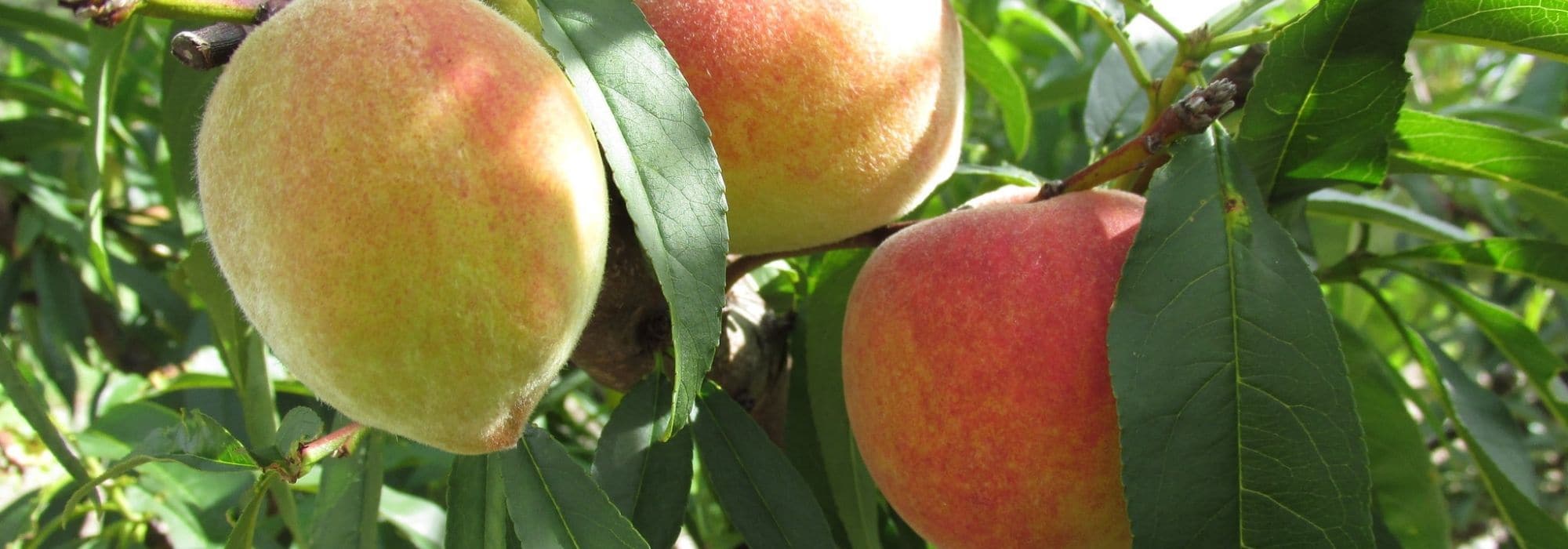
Peach: planting, growing, pruning, harvesting
Contents
Peach in a nutshell
- Although hardy down to -15 °C, the peach tree prefers regions with a mild climate: its flowering is particularly sensitive to late spring frosts.
- This fruit tree with a spreading habit offers pink or white flowers and summer fruiting from mid-June to mid-September.
- There are over 300 distinct varieties of peaches, characterised by their epidermis, flesh colour, and stone.
- The peach tree thrives in ordinary, light, deep, but well-drained soils.
- This fruit tree requires regular pruning and is quite susceptible to several diseases.
A word from our expert
A fruit tree from the Rosaceae family, the peach (Prunus persica) boasts over 300 varieties distinguished by their epidermis, either velvety or smooth, by their stone being free or not, and by their flesh being white, yellow, or nearly red. Very old, local, or resulting from hybridization, these peach varieties are mainly classified into four categories: the classic peach, the pavie peach, the nectarine, and the brugnon.
All are originally from Asia and then passed through Persia along caravan routes before finally arriving in the Mediterranean region, where they found a climate favourable for their cultivation. The peach tree indeed thrives in regions with a mild climate, particularly around the Mediterranean, where it fruits abundantly. Elsewhere, it can grow, but late spring frosts may jeopardise its flowering and, consequently, its fruiting.
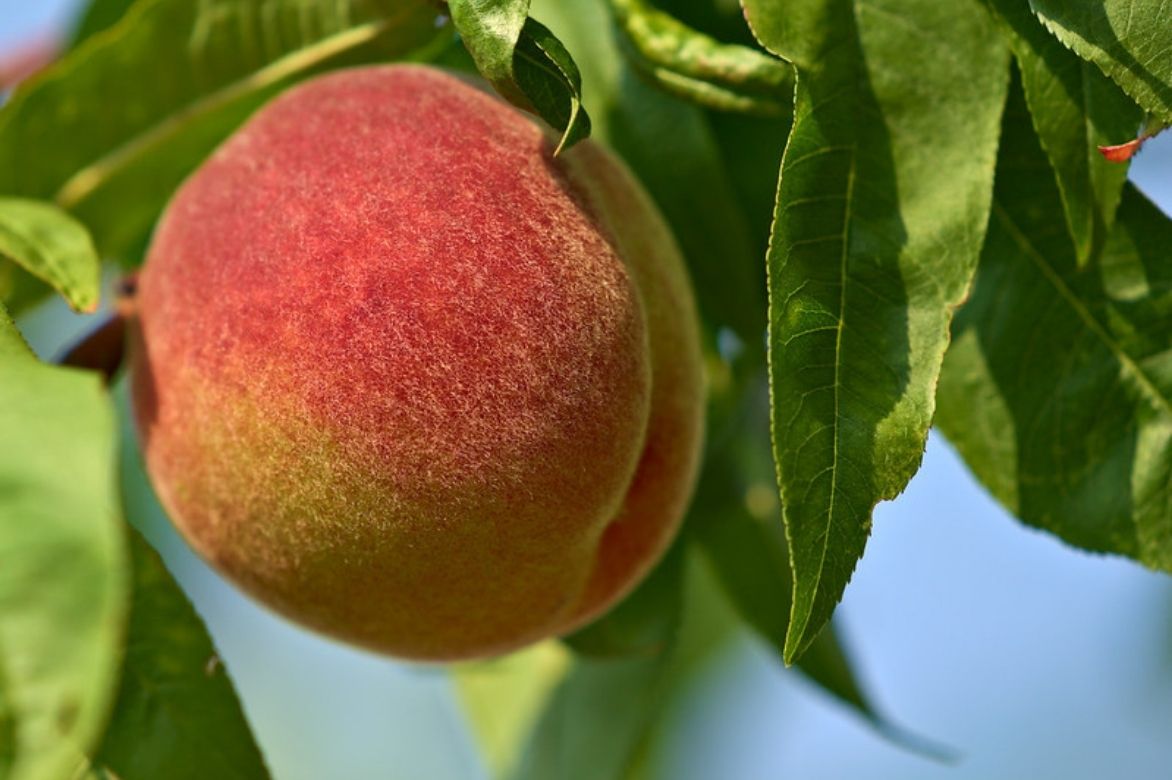
The fruiting of the peach tree can be compromised by late spring frosts
However, the peach tree can be cultivated north of the Loire, in an espalier against a sun-exposed wall or in a pot. But fruiting is never guaranteed… One can enjoy the lovely white or pink flowering of the peach tree, which occurs at the beginning of spring and lasts until mid-April, depending on the climate.
With a spreading habit, the peach tree grows in ordinary, well-drained, and deep soils. Fast-growing and self-fertile, it fruits for 15 to 20 years. It will require regular pruning and some care to prevent the few diseases to which it may be susceptible.
Description and botany
Botanical data
- Latin name Prunus persica
- Family Rosaceae
- Common name peach
- Flowering spring
- Height up to 6 metres
- Exposure full sun
- Soil type Ordinary, deep and rich soil
- Hardiness down to -15°C
Prunus persica is a fruit tree belonging to the Rosaceae family, which includes other notable members such as the apple, pear, and cherry.
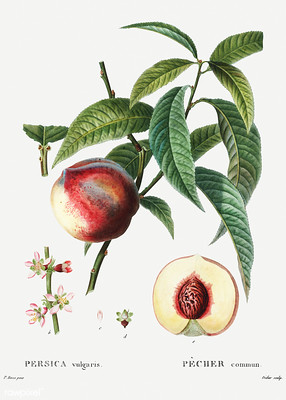
Botanical illustration
Although its Latin etymology suggests that the peach originates from Persia, this is not the case (even though it did pass through Persia!). The peach is originally from China, where it has been cultivated since ancient times. Confucius (-551 / -479) mentions it in his writings under the name Tao. It was certainly Alexander the Great who, in the 4th century BC, introduced it to the Mediterranean region from Persia and through Egypt (hence the name given by the Greeks and Romans, who initially called it Malum persicum or Persian apple).
In France, the peach gained recognition thanks to Louis XIV, who was fond of it. However, it was primarily his gardener, Jean-Baptiste La Quintinie, Director of the King’s fruit and vegetable gardens, who is credited with the selection work that resulted in over thirty new varieties planted in the gardens of the Palace of Versailles, including the remarkable Têton de Vénus and Belle de Chevreuse. Legend has it that it was actually Girardot, a musketeer of the king turned gardener, who first managed to train peach trees on espaliers in Montreuil, near Paris. He produced wonderful peaches that he eagerly offered to the King every year. His garden quickly became a popular walking spot. La Quintinie felt overshadowed and also began cultivating peaches on espaliers, despite considering this fruit tree to be untameable. But that is just a little history… Nevertheless, Montreuil (and Bagnolet) became a significant site for peach cultivation on espaliers, continuing until the 19th century. Gardeners practiced the “loque” training method, and many varieties of peaches were born there: Alexis Lepère, Belle Beausse, Belle Henri Pinault, Belle Impérial, Bourdine, Galande, Grosse Mignonne… These peach walls now cover 35 hectares and are classified as a regional heritage site in Seine-Saint-Denis, undergoing restoration since 2021.
This famous peach also inspired a renowned chef. Indeed, Auguste Escoffier, “chef of kings and king of chefs,” created the Poire Belle-Hélène in 1864 and the Pêche Melba 30 years later. The man was passionate about lyrical art and dedicated his ice dessert to Nellie Melba, a soprano he particularly admired.
In China, the peach tree is a symbol of longevity and immortality, while in Japan, it protects against evil.
This fruit tree has an erect habit when young, becoming spreading over time. Fast-growing, it can bear fruit for 15 to 20 years, or even longer if the growing conditions are suitable. Hardy down to -15°C, the peach tree is, however, sensitive to late spring frosts that damage its flowers and compromise fruiting.
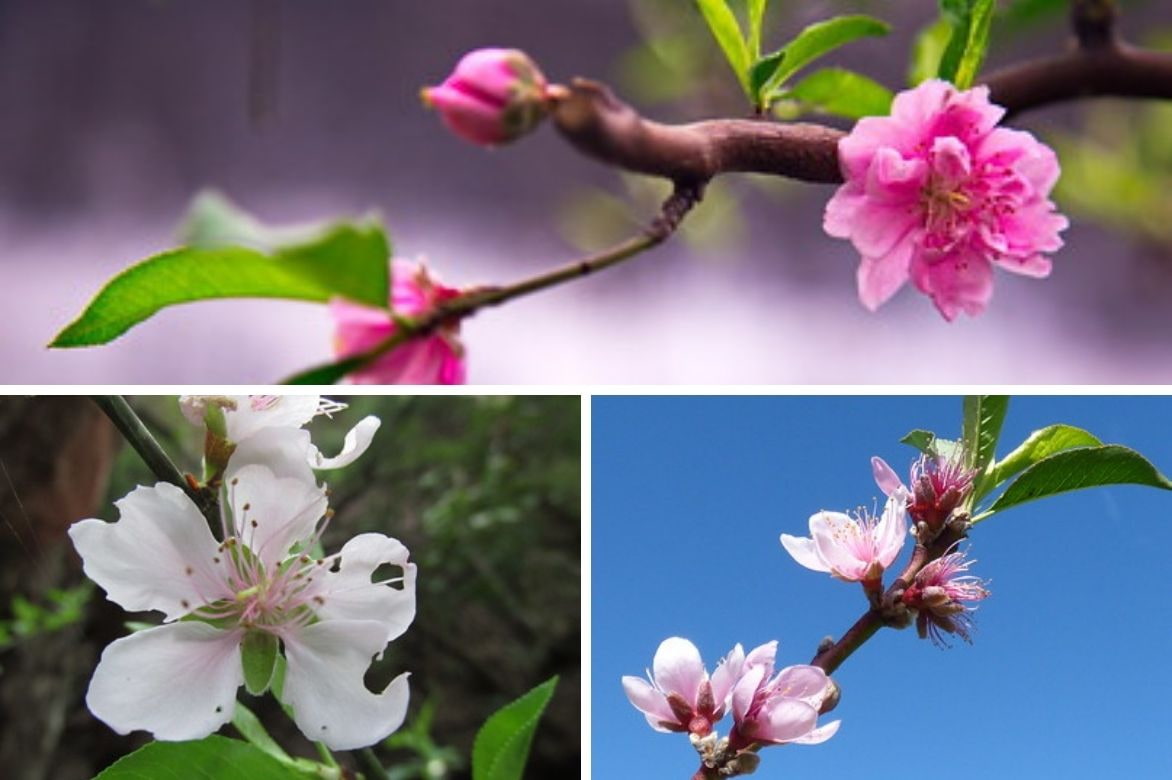
Peach flowers can be white or pink, varying in intensity.
It can reach a height of 6 metres, but generally grows to 4 to 5 metres. As for dwarf peaches, perfect for pot cultivation or small gardens, they rarely exceed 1.5 metres in height and 1 metre in width.
The bark of its trunk has a smooth, slightly cracked appearance.
The peach tree flowers between late February and April, depending on the region. The flowers appear before the leaves on the previous year’s branches. Solitary, its pink or white flowers are hermaphroditic. Nectariferous and pollen-rich, they attract many insects. Each flower has 5 small campanulate petals or large petals with rounded edges. Generally, there are 20 to 25 stamens. As the flowers arise on last year’s shoots, only the wood from the last shoot produces fruit (and buds), meaning that a branch only bears fruit once.
The peach tree is self-fertile.
The deciduous foliage of the peach tree is slightly fragrant, emitting a sweet almond scent. A beautiful bright green, the leaves are delicately wrinkled, lanceolate, narrow, and acuminate (tapering to a point). Measuring 8 to 15 cm long and 3 to 4 cm wide, they have a crenate margin. Their petiole is short and equipped with 2 or 3 nectaries (glands secreting nectar).
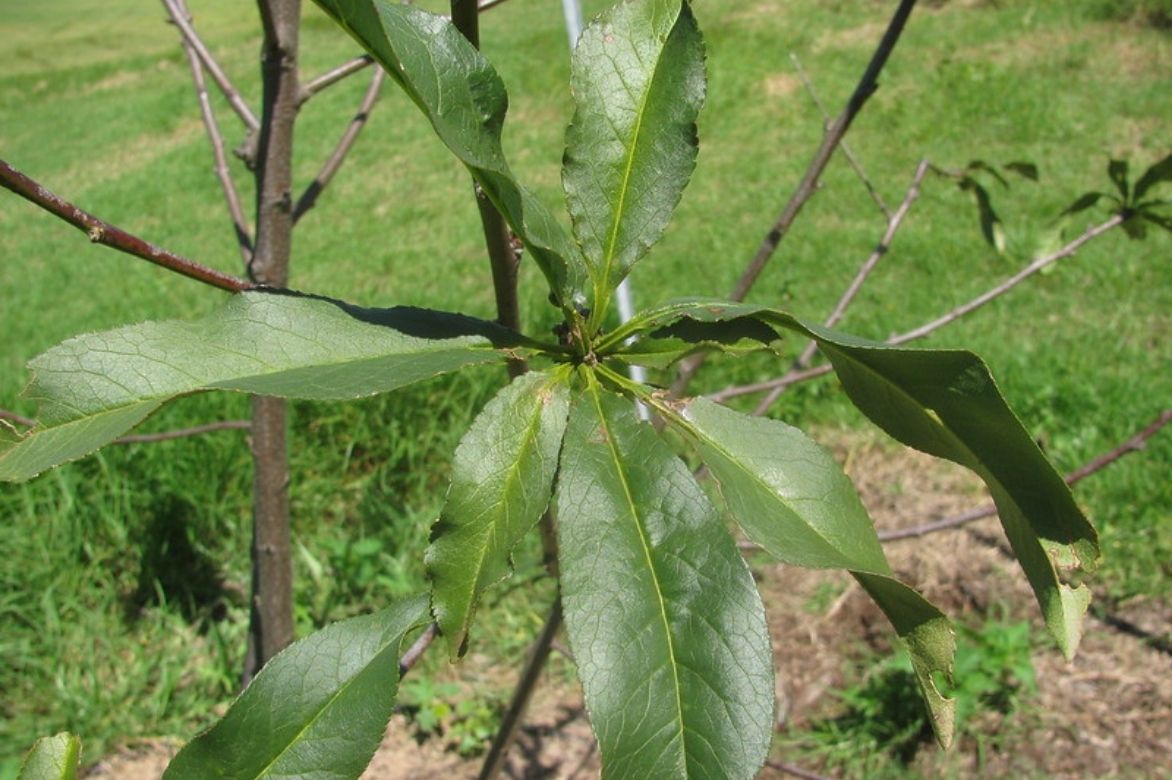
The leaves of the peach tree are narrow and lanceolate.
From the 2nd or 3rd year for some varieties, more reliably the 4th year, the fruits reach maturity between mid-June and mid-September, depending on the varieties and climate. Highly fragrant and sweet, peaches have white, pinkish-white, or yellow juicy flesh. These globular drupes develop around an ovoid stone, deeply marked with grooves. It is usually free, meaning the flesh separates easily from the stone. As for the epidermis, it can be fuzzy and velvety or smooth for nectarines and plums.
“`
Read also
Peach leaf curlThe different varieties of peach trees
Peaches, nectarines, and flat peaches, whether yellow or white-fleshed… Peaches come in various shapes and colours depending on the varieties. However, there are four distinct types:
- Classic peaches with white flesh, fuzzy epidermis, and free stone such as ‘Amsden’, ‘Grosse Mignonne’, and ‘Téton de Vénus’
- Pavie peaches with yellow flesh adhering to the stone and fuzzy epidermis such as ‘Dixired’ and ‘J.H. Hale’
- Nectarines with white flesh, smooth and glabrous epidermis, and free stone such as ‘Morton’ and ‘Olympio’
- Flat peaches with yellow flesh adhering to the stone and smooth skin.
Nonetheless, selections have led to the creation of yellow-fleshed nectarines and white-fleshed flat peaches. We can also add to this selection the vine peaches with white flesh veined with red and the flat peaches.
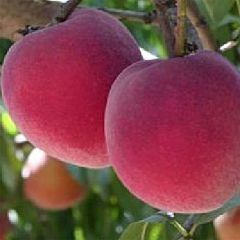
Prunus persica Queen of Orchards - Peach Tree
- Flowering time April
- Height at maturity 5 m
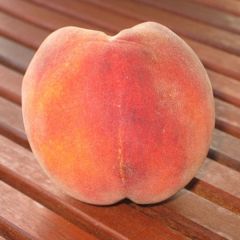
Prunus persica Redhaven - Peach Tree
- Flowering time March, April
- Height at maturity 4 m
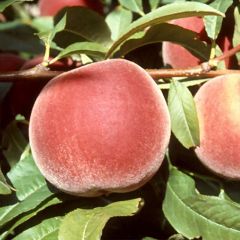
Prunus persica Michelini - Peach Tree
- Flowering time April, May
- Height at maturity 4 m
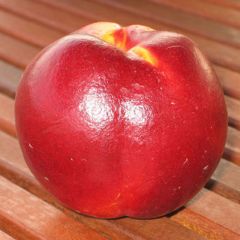
Prunus Fantasia - Nectarine Tree
- Flowering time April
- Height at maturity 5 m
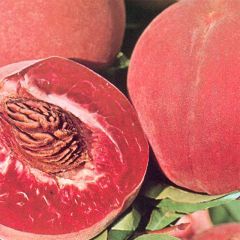
Prunus persica Sanguine - Vineyard Peach Tree
- Flowering time May
- Height at maturity 5 m
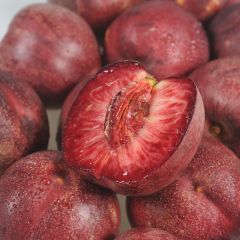
Prunus persica Sanguine d'Auvergne - Nectarine tree
- Flowering time April, May
- Height at maturity 6 m
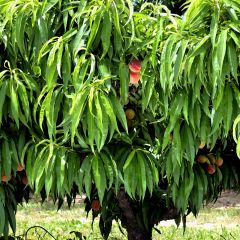
Dwarf Peach Amber Pix Zee
- Flowering time April, May
- Height at maturity 1,50 m
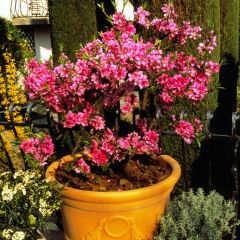
Prunus persica Diamond Zaipevi - Dwarf Peach
- Flowering time April, May
- Height at maturity 1,50 m
Discover other Peach and Nectarine trees
View all →Available in 1 sizes
Available in 1 sizes
Available in 1 sizes
Available in 1 sizes
Available in 4 sizes
Available in 1 sizes
Available in 1 sizes
Available in 2 sizes
Available in 1 sizes
Available in 1 sizes
Planting a peach tree
Where to plant?
The peach tree should be planted in full sun, sheltered from drafts and cold winds. A south-east or south-west exposure is ideal. If you do not live in the south of France, the peach tree can be trained against a south-facing wall. In regions that frequently experience late spring frosts, it will be more difficult, if not impossible, to produce fruit from a peach tree.
It requires ordinary soil that is rich, deep, and well-drained. The peach tree dislikes heavy, waterlogged soils, as well as calcareous soils.
When to plant?
The planting period depends on the form of the peach tree. Thus, a bare-root peach tree should be planted from October to March, traditionally around Saint Catherine’s Day, avoiding frost periods. A bare-root fruit tree must be planted immediately after purchase, as the roots should not be exposed to sunlight and air. If you cannot plant it immediately, heel it in while you wait.
If purchased in a container, the peach tree can be planted in autumn, from October to December, again avoiding frost periods, or even in spring.
How to plant?
- Dig a hole at least 60 cm deep and 1 metre wide, at least a week before planting.
- Remove all stones and adventive plants.
- Place the container in a basin to moisten the root ball by capillarity.
- Throw two handfuls of crushed horn into the bottom of the hole.
- Mix the extracted soil with well-matured compost, well-decomposed manure, or potting soil.
- Backfill the hole with half of the extracted soil.
- Plant a stake at least 50 cm deep.
- Position the peach tree in the hole.
- Fill in with the remaining soil.
- Gently firm the soil around the peach tree, which you will tie to the stake.
- Create a basin and water generously.
Proceed in the same way if you are planting a bare-root peach tree. But do not forget to dress and coat the bare roots before planting.
For pot planting, choose a relatively large pot of at least 40 cm in depth and width. After covering the bottom with clay balls or coarse gravel, fill the pot with a mixture of garden soil, potting soil, and sand. Then proceed as you would for planting in the ground. You can add a small dose of fertiliser for fruit trees at the time of watering.
Read also
How to protect fruit trees from birds?Peach tree care
To develop and bear fruit properly, the peach tree requires some care. Starting with regular watering from April to September, early in the morning or late in the evening. However, these waterings should not be excessive as the peach tree is sensitive to excess moisture. To space out the waterings, mulching can be beneficial, especially during the hot summer months.
A feed for fruit trees is recommended in spring. In autumn, a little manure or compost can be added by scratching the surface of the soil around the trunk.
As the peach tree is particularly susceptible to fungal diseases, preventative sprays of Bordeaux mixture can be applied at the time of bud burst. This treatment can be repeated a second time, 10 days later. Another spray will take place in autumn, after the leaves have fallen.
Pruning the peach tree
Depending on whether you grow your peach tree in the open or as a fan, the pruning will be different. Two types of pruning are necessary: a formative pruning and a fruiting pruning. This is simply because the peach tree produces a lot of dead wood. Indeed, the branches that have borne fruit die off, and fruiting occurs on shoots from the previous year.
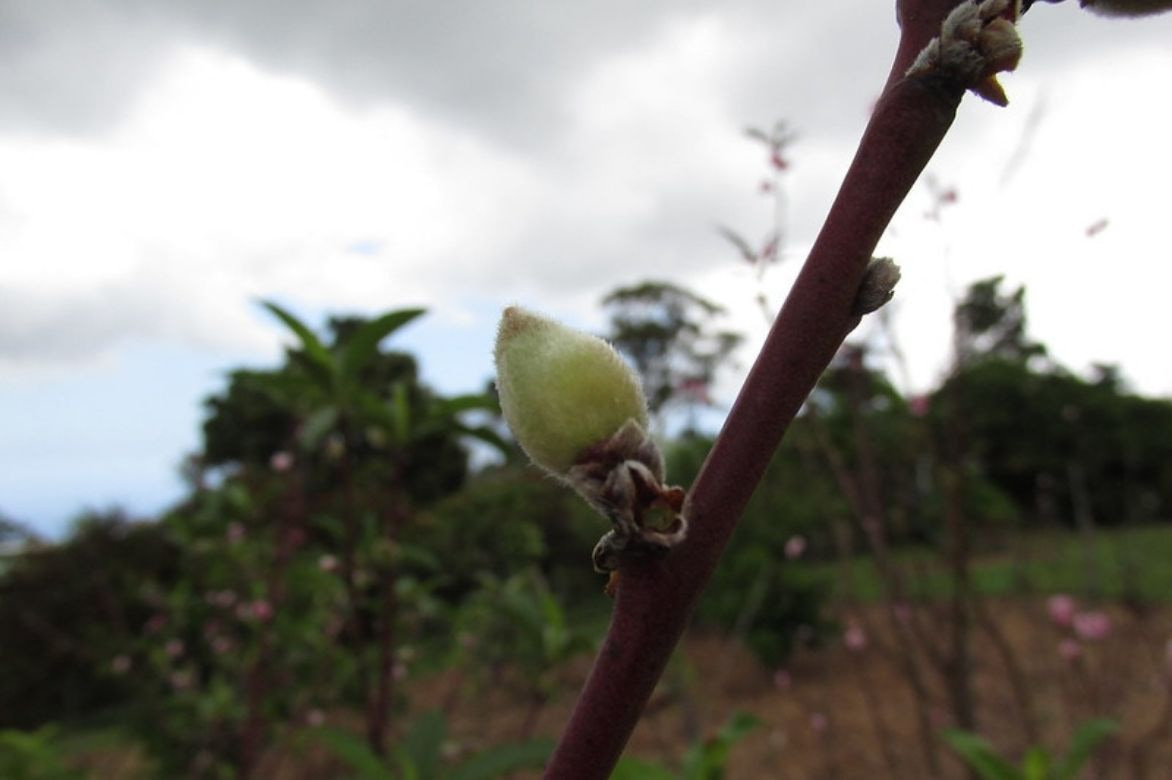
On peach trees, fruits form on the previous year’s branches
Formative pruning
This is done on young peach trees. The aim is to keep the 3 to 5 largest and most vigorous main branches and to remove weaker or poorly placed branches. After that, it can be carried out every 5 years to aerate the tree’s branches.
Fruiting pruning
This annual pruning allows for the renewal of wood, which is essential for fruiting. To minimise mistakes, it is preferable to prune in February or March at the time of bud burst to distinguish between wood buds and flower buds. Sterile wood shoots should be cut above the second bud to redistribute the sap. This way, a new shoot will emerge.
For mixed shoots that produce both types of buds, you should prune to retain the two buds located near the base of the shoot, along with three or four flower buds and one wood bud above.
Some also practice a green pruning after fruiting and leaf drop. This involves cutting the tips of the shoots.
These prunings should always be carried out with a sharp and disinfected pruning shear or a loppers. To limit the appearance of diseases, it is also recommended to apply a healing paste on the cuts.
→ Also read our tutorial Why and how to thin fruit trees?
Diseases and pests of the peach tree
As with many fruit trees, the peach tree is relatively susceptible to fungal diseases. Starting with the aptly named peach leaf curl. This fungus overwinters under the scales of the buds and thrives in cold, damp weather when the leaves emerge. Affected leaves show raised yellow spots, and the upper surface becomes distorted. The leaves eventually fall off, and young shoots may become deformed. Eva explains in detail how to prevent and treat this disease.
Other fungal diseases also regularly affect the peach tree, namely powdery mildew, identifiable by the white fluff on the leaves, and brown rot. A preventive treatment with Bordeaux mixture is often effective. This should be applied in spring.
It is not uncommon for bacterial canker to also attack the peach tree. Infection occurs in autumn through leaf scars and bark injuries. Removing affected parts and spraying with Bordeaux mixture can help limit the spread of canker.
Another common disease of the peach tree is shot hole disease, which manifests as small, round, reddish-brown spots on young leaves. Later, the leaves dry out and become dotted with small holes bordered in red. As the fungus overwinters on fallen leaves, it is important to collect them carefully.
In recent years, a new disease has caused significant damage to peach and apricot trees: the Sharka virus, which appears as pale spots on leaves, shoots, and fruits. This incurable disease primarily affects Prunus.
Finally, pests also target peach trees, such as aphids, mealybugs, and the codling moth. For the oriental fruit moth and thrips, there are very effective pheromone traps.
Read also: How to combat the Mediterranean fruit fly?
Harvesting and storing peaches
The harvest of peaches takes place from mid-June for the earliest varieties to mid-September for the later ones, such as vine peaches. The harvest occurs when the fruits are coloured at the neck, soft to the touch, and emit a sweet fragrance. Since peaches are very fragile, there is no need to consider shaking. Peaches are harvested by hand with care and placed gently in a basket.
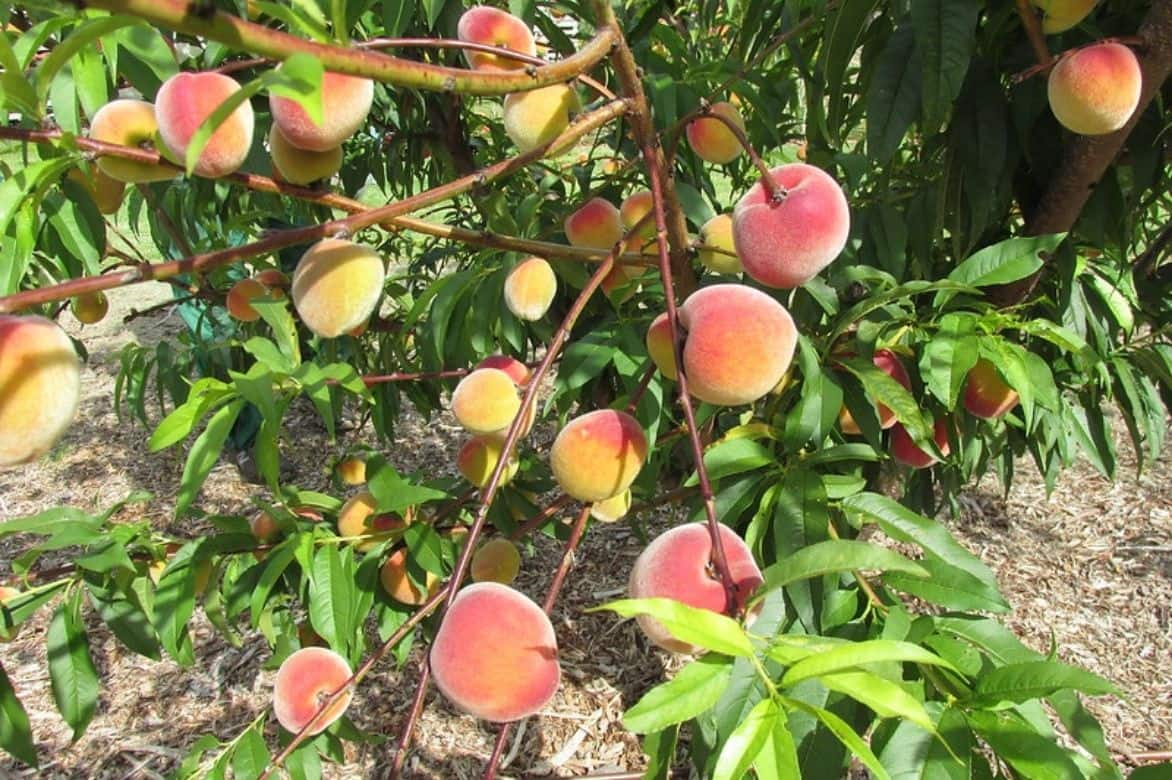
Peaches are harvested when they are well coloured at the neck
Once harvested, peaches can be stored for a week in a cool place, away from light. As they are climacteric fruits, they continue to ripen after harvest. You can also store them in the refrigerator.
Raw peaches can be frozen, either whole with the stone, or cut in half or into small pieces. It all depends on what you want to do with them once thawed.
You can also make peaches in syrup in sterilised jars.
Like apricots, peaches can be dried. Start by slicing them. They can then be dried in the sun at a minimum of 25 °C for a week, in the oven at 50 °C for 8 to 16 hours, or in a dehydrator for 12 to 18 hours.
How to consume peaches?
Peaches can be eaten raw or cooked, in compotes, jams, crumbles, clafoutis, or tarts… They can also accompany a savoury meat dish (duck, rabbit, chicken…) or fish such as salmon or cod, simply sautéed or grilled in the oven. They are also included in the composition of ice creams and sorbets, smoothies, fruit salads, can be made into coulis, and served in a salad or with Bayonne ham.
Peaches are rich in antioxidants, fibre, and vitamins C and E, as well as carotin, iron, and copper, while being medium in calories.
Peach propagation
Of course, you can always try grafting with a shield to multiply a peach tree, but this is a delicate operation best left to a professional. It is especially crucial to choose a rootstock suitable for your climate and the nature of your soil. The rootstock can be a seedling peach, a plum, or an almond tree.
Otherwise, the simplest method to multiply a peach tree is by sowing the stone in September. The easiest peach trees to multiply by sowing are vine peaches. Preferably, choose older varieties.
- Carefully remove the flesh surrounding the stone with a stiff brush
- Place clay balls or gravel at the bottom of a large pot
- Fill the pot halfway with a mixture of 2/3 sand and 1/3 potting soil
- Plant several stones in different strata and cover with sand and potting soil
- Place the pot against a wall throughout the winter, ensuring it retains a minimum of moisture.
In spring, young shoots will have appeared. Transplant them into individual pots or into the ground in a mild climate. Fruits may appear as early as the third year.
For further reading
- Discover our wide range of peach and nectarine trees, available to order online
- Don’t miss out on the best varieties of peach and nectarine trees
- To care for them properly, check out our guide: Diseases and pests of the peach tree
- Learn to recognise the most frost-sensitive fruit trees
- Advice sheet: What is a rootstock and which one to choose?
- Our article: How to choose a peach or nectarine tree?
- Subscribe!
- Contents































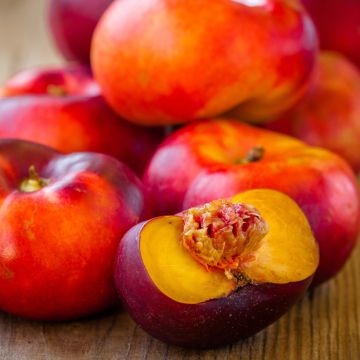
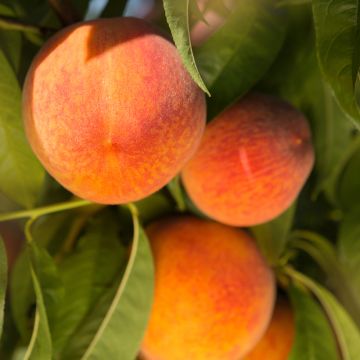
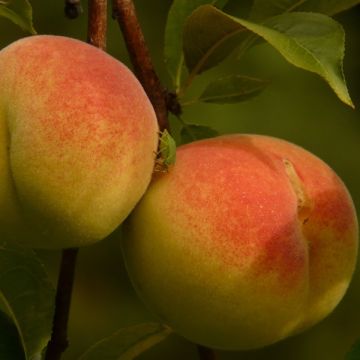
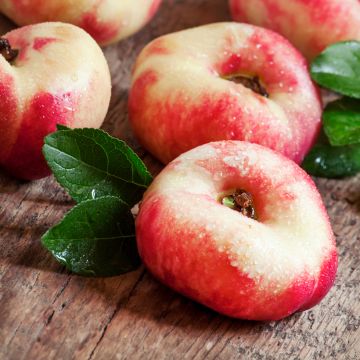

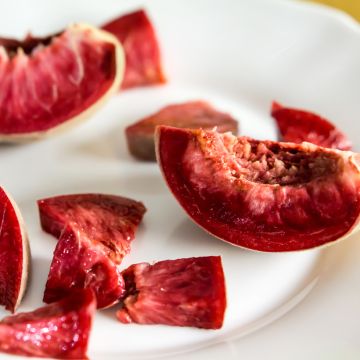
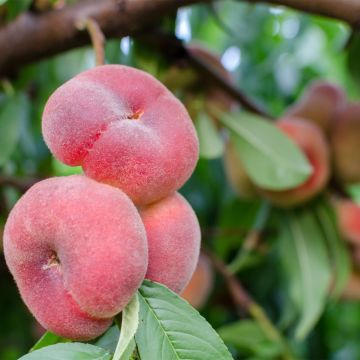
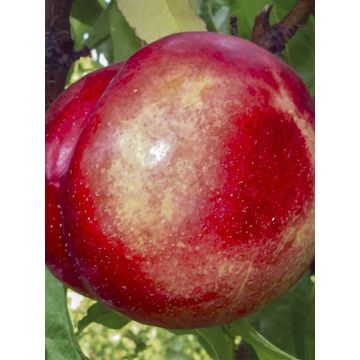
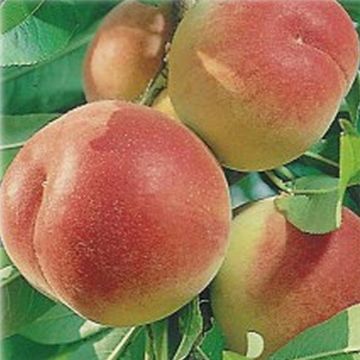
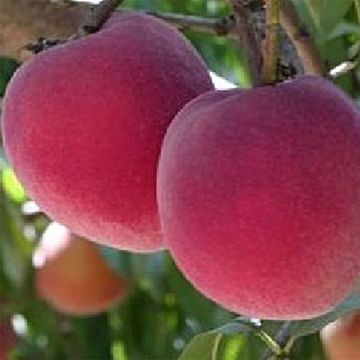
Comments